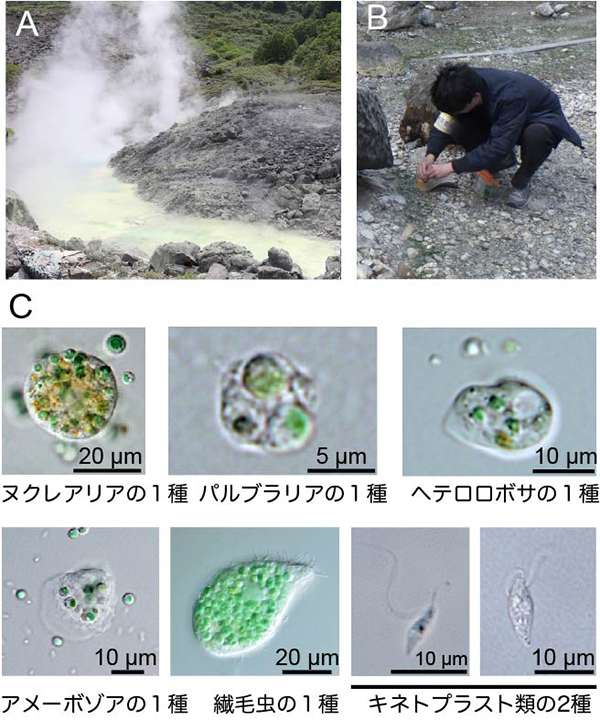2025-05-12 国立遺伝学研究所

図:硫酸酸性温泉から単離・培養された単細胞真核生物
(A)硫酸酸性温泉の環境、(B)現地で試料を採集する砂田さん、(C)本研究で発見され、培養に成功した単細胞真核生物の顕微鏡像(細胞内の緑色のものは、細胞内に取り込み消化中の微細藻類イデユコゴメ)
<関連情報>
- https://www.nig.ac.jp/nig/ja/2025/05/research-highlights_ja/rh20250430.html
- https://academic.oup.com/femsec/article/101/5/fiaf048/8123406
中程度の高温の地熱硫黄泉に生息する単細胞紅藻類シアニディオコッカス属を餌とする従属栄養性単細胞真核生物 Heterotrophic unicellular eukaryotes feeding on the unicellular red alga Cyanidiococcus sp. in moderately hot geothermal sulfuric springs
Yuki Sunada , Dai Tsujino , Shota Yamashita , Wei-Hsun Hsieh , Kei Tamashiro , Jin Izumi , Fumi Yagisawa , Baifeng Zhou , Shunsuke Hirooka , Takayuki Fujiwara …
FEMS Microbiology Ecology Published:30 April 2025
DOI:https://doi.org/10.1093/femsec/fiaf048
Abstract
Sulfuric acidic hot springs (<pH 4.0, >37°C) are found in volcanic regions worldwide, where various bacteria, archaea, and the unicellular red algae Cyanidiophyceae dominate. Regarding heterotrophic eukaryotes, the only known species was the thermophilic amoeboflagellate Tetramitus thermacidophilus (class Eutetramitea, phylum Heterolobosea), which feeds on surrounding bacteria and archaea. In this study, we investigated three sulfuric hot springs (34.7°C–50°C, ∼pH 2.0) in Japan to determine whether other heterotrophic eukaryotes inhabit these environments. As a result, we isolated and identified cultures of four species capable of surviving at pH 2.0 and 40°C: Allovahlkampfia sp. (Eutetramitea, Heterolobosea); Nuclearia sp. and Parvularia sp. (Nucleariidea, Cristidiscoidea); and Vannella sp. (Discosea, Amoebozoa). Phylogenetic analyses suggest that these four species independently evolved from mesophilic and neutrophilic ancestors, separate from each other. Additionally, Platyophrya sp. (Colpodea, Ciliophora) and two species of Neobodo (Euglenozoa, Kinetoplastea) were also found in the same environment, while their maximum survival temperatures were 35°C and 30°C, respectively. Among these, all species except Neobodo were confirmed to grow exclusively by feeding on Cyanidiococcus sp., a dominant species of Cyanidiophyceae in the environment. Thus, various lineages of heterotrophic unicellular eukaryotes have independently developed acidophilic and thermotolerant traits, allowing them to colonize sulfuric hot springs.


